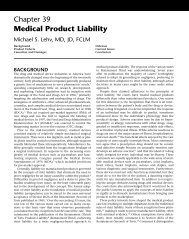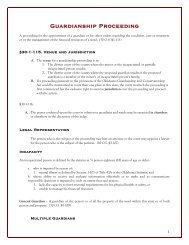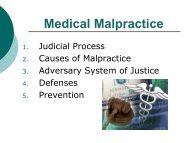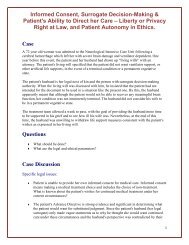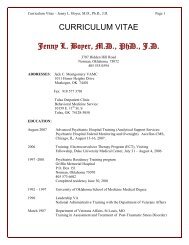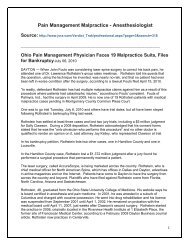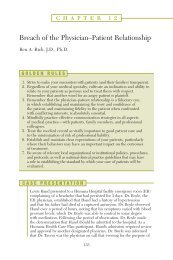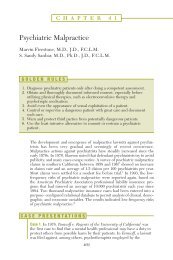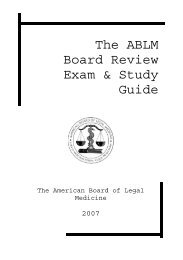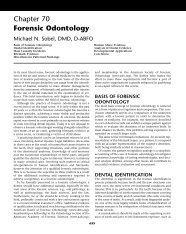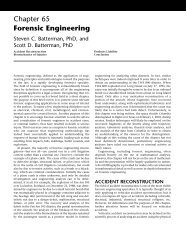Disclosure, Empathy and Apology: Objectives Disclaimer
Disclosure, Empathy and Apology: Objectives Disclaimer
Disclosure, Empathy and Apology: Objectives Disclaimer
You also want an ePaper? Increase the reach of your titles
YUMPU automatically turns print PDFs into web optimized ePapers that Google loves.
<strong>Disclosure</strong>, <strong>Empathy</strong> <strong>and</strong> <strong>Apology</strong>:<br />
Staying on the Same Side of the Table<br />
<strong>Objectives</strong><br />
Underst<strong>and</strong> the process of disclosure, empathy <strong>and</strong> apology<br />
Identify practices that will lay the groundwork for successful<br />
disclosure<br />
Differentiate between empathy <strong>and</strong> apology<br />
Underst<strong>and</strong> that the disclosure process is good for patients,<br />
families <strong>and</strong> the physician<br />
<strong>Disclaimer</strong><br />
This information is not intended to be legal advice <strong>and</strong> is not<br />
intended to establish guidelines <strong>and</strong>/or the st<strong>and</strong>ard of care<br />
PLICO is not a regulatory agency<br />
PLICO does not dictate, m<strong>and</strong>ate or identify practice<br />
protocols to be used<br />
PLICO does not ensure practitioner compliance with<br />
guidelines
SorryIt’s in the News<br />
5
“People sue people, not events”<br />
“Litigation arises not simply from medical error but from an<br />
unanticipated outcome coupled with an inability or refusal by<br />
medical staff to communicate effectively with a patient or the<br />
patient’s family.”<br />
Geri Amori, Ph.D. –<br />
Healthcare risk manager <strong>and</strong> consultant-Collins Medical Professional Liability<br />
Networking Forum, April 2008, reported in Collins Professional Liability Insights,<br />
Vol. 3, No. 1 5/14/2008<br />
<strong>Disclosure</strong> is a continuum<br />
Five-Star<br />
Resolution<br />
Loyalty<br />
<strong>Disclosure</strong><br />
Follow-up<br />
Benchmarkings, Ratings,<br />
Heightened Focus on Quality<br />
Hospitals & Health Networks,<br />
December 2007
Five-Star Culture<br />
What does it mean<br />
Definition of “Five-Star”:<br />
Top-quality--having the highest quality (Encarta® World English Dictionary[North<br />
American Edition] )<br />
Indicating the highest classification, based on a given set of criteria for<br />
determining excellence--a five-star rating (Webster’s New World College Dictionary)<br />
Of first class or quality (Merriam-Webster’s Online Dictionary)<br />
Five-Star Culture<br />
Treating staff, colleagues, physicians <strong>and</strong> patients at the<br />
highest level of service – internal <strong>and</strong> external<br />
Providing an unprecedented level of service<br />
Leaving a lasting positive fingerprint<br />
Consistent...pervasive...particularly with stress!<br />
Five-Star Culture<br />
More than a positive attitude
Burn the “BUSY” Card<br />
Start with the Basics<br />
Five-star begins…<br />
With your attitude…personalize it!<br />
• At the patient’s first contact with the practice<br />
• At each member’s contact with each other!<br />
Then each linkage…<br />
Say “good morning” or “good afternoon”<br />
Make eye contact<br />
Be…<br />
Reassuring<br />
Interested<br />
Friendly<br />
Warm<br />
Even on your worst day!<br />
The Specifics—The Call<br />
Literally how the phone is<br />
answered<br />
Remember – patients can<br />
see over the phone line<br />
Opportunities<br />
You can connect or not!<br />
Warmth <strong>and</strong> interest can be<br />
communicated or not!
The Specifics—The Reception<br />
Greeting<br />
The setting<br />
Organized<br />
Positive distractions<br />
Clean<br />
Confidentiality being protected<br />
The “call back”<br />
Invitation<br />
Opportunities<br />
I’m interested<br />
I care<br />
I respect you<br />
Everyone!<br />
The Specifics—The Wait<br />
#1 complaint<br />
Five-star<br />
Dem<strong>and</strong> management<br />
Expectation management<br />
The apology..<br />
Prevention<br />
Auditing<br />
Signs
We are sorry!<br />
We always try to meet your<br />
scheduled appointment time.<br />
Sometimes we run late <strong>and</strong><br />
we apologize. Sometimes a<br />
patient takes longer with a visit<br />
than we anticipate.<br />
Sometime it may be you!<br />
let the receptionist know<br />
if you have been waiting<br />
for more than 15 minutes.<br />
The Specifics—The Visit<br />
Greet<br />
Sit down<br />
Look at them!<br />
Body language<br />
Communication
The Specifics—The Visit<br />
Providing written discharge, or after care, instructions can<br />
serve the patient, <strong>and</strong> the physician, well following<br />
completion of the office visit. Written discharge instructions<br />
may be indicated when:<br />
the patient has had a minor procedure in the office<br />
detailed instructions are required, such as tapering medications<br />
the patient is to monitor for specific signs <strong>and</strong> symptoms that<br />
result in an action<br />
the patient has learning, memory or comprehension deficits<br />
the patient has a new or complex diagnosis<br />
The Specifics—Complaints<br />
Service Recovery<br />
• Empathize<br />
• Underst<strong>and</strong>ing concerns/validation<br />
• Remediate<br />
• Listen<br />
• Explain<br />
• Follow through<br />
Create the Loyal Patient Relationship<br />
Five-star will help to create the trusting relationship that will<br />
transcend an event<br />
Allows for service recovery<br />
Defuse the angry patient<br />
It is a loyal relationship<br />
Not just with the patient<br />
Also the family
<strong>Disclosure</strong> is a continuum<br />
Five-Star<br />
Resolution<br />
Loyalty<br />
<strong>Disclosure</strong><br />
Follow-up<br />
Sorry Works!—the Concept<br />
“Sorry” is defined in the dictionary as:<br />
“feeling sorrow, regret, or penitence”<br />
“mournful, sad”<br />
“inspiring sorrow, pity, scorn, or ridicule: pitiful”<br />
Sorry Works!<br />
Underst<strong>and</strong> that “empathy” is appropriate 100% of the time<br />
Underst<strong>and</strong> that communication about unanticipated<br />
outcomes in the right way, by the right people is key<br />
Underst<strong>and</strong> a workable process for disclosure which can<br />
reduce liability exposure<br />
Recognize the difference between an empathetic “I’m<br />
sorry” <strong>and</strong> “apology”<br />
Know how to apologize to patients <strong>and</strong> families
Post-Adverse Event Communication<br />
is Key<br />
With a Proper Program You Can<br />
IMPACT….<br />
♒♒ a patient sees a lawyer in the first instance<br />
♒♒ the lawyer takes the case<br />
♒♒ a juror awards damages<br />
Patients Will See a Lawyer When<br />
A lack of “relationship”<br />
Lack of or poor<br />
communication<br />
Lack of event<br />
management<br />
Lack of disclosure
The failure to<br />
communicate is a catalyst<br />
for converting patients to<br />
plaintiffs.<br />
How Plaintiff Lawyers Use the “Plus”<br />
<br />
<br />
Selective cases being pursued<br />
Consolidation of counsel<br />
Courtroom drama will continue 2<br />
<br />
Complications coupled with a<br />
“plus”<br />
2 Garrison J. “Lawyers learn to share their pain with jurors: They use a technique called psychodrama<br />
to connect better by showing vulnerability.” LA Times 2006, Nov. 25.<br />
Sorry Works!<br />
It’s all about staying on the same side of the table
Sorry Works!<br />
<strong>Empathy</strong> is appropriate<br />
100% of the time<br />
Sorry Works!<br />
…Knowing the difference<br />
“I’m sorry” = <strong>Empathy</strong><br />
“I apologize” = Accepting responsibility<br />
Important that your patients know which you mean<br />
<br />
<br />
<br />
An Empathetic “Sorry”<br />
“Mrs. Jones, the surgery is over <strong>and</strong> I know you were looking forward to taking your mom<br />
home in a few days…you have that big birthday party with gr<strong>and</strong>kids in a few days. But, I’m<br />
sorry to tell you she is in the ICU…..the surgery didn’t work out the way we expected. I’m so<br />
sorry…”<br />
“I can only imagine how upsetting this must be for you <strong>and</strong>, again, I’m very sorry this<br />
happened. Please know we are doing an investigation <strong>and</strong> will have some initial answers to you<br />
in the next two days…..”<br />
“Please underst<strong>and</strong> your mom is receiving the best care possible <strong>and</strong> we are going to keep you<br />
posted on her progress…..”<br />
<br />
“In the meantime, is there anything I can do for you Food or transportation Can I help<br />
making phone calls Do you need a minister Here’s my business card….don’t hesitate to call<br />
me. I feel so bad for you….I’m sorry.”
What Was Said<br />
‣ Speed: “I’m sorry” should be provided as soon as possible after adverse<br />
event.<br />
‣ <strong>Empathy</strong> personalized <strong>and</strong> feelings of patient/family acknowledged<br />
‣ The “s” word<br />
‣ Taking the situation seriously<br />
‣ Customer service elements<br />
‣ Staying connected!<br />
What Was NOT Said<br />
No Admission of fault – yet!<br />
Do NOT prematurely admit fault or play retrospection game<br />
No jousting or speculation – not time to throw<br />
colleagues under the bus!<br />
When to APOLOGIZE<br />
PAUSE!<br />
Investigate<br />
Communicate<br />
Collaborate
Final Thoughts<br />
Five-Star Customer service improves patient satisfaction<br />
Satisfied patients are more likely to be loyal <strong>and</strong> return to<br />
your practice following an adverse event<br />
Satisfied patients are less likely to sue should an adverse event<br />
occur<br />
<strong>Empathy</strong> is appropriate 100% of the time<br />
It is important to know the difference between “sorry” <strong>and</strong><br />
“apology”<br />
<strong>Disclosure</strong> is a continuum<br />
Thank you



